2.5 Are There Other Earths?
As of July 2021, 4,777 exoplanets—extrasolar planets, or planets outside of our solar system—have been confirmed. An additional 4,640 potential exoplanets have been detected and await confirmation. The majority of exoplanets have been detected using the transit technique, which involves looking for periodic fluctuations in light from a star from planets transiting in front of the star, causing it to appear dimmer (Figure 2.15).
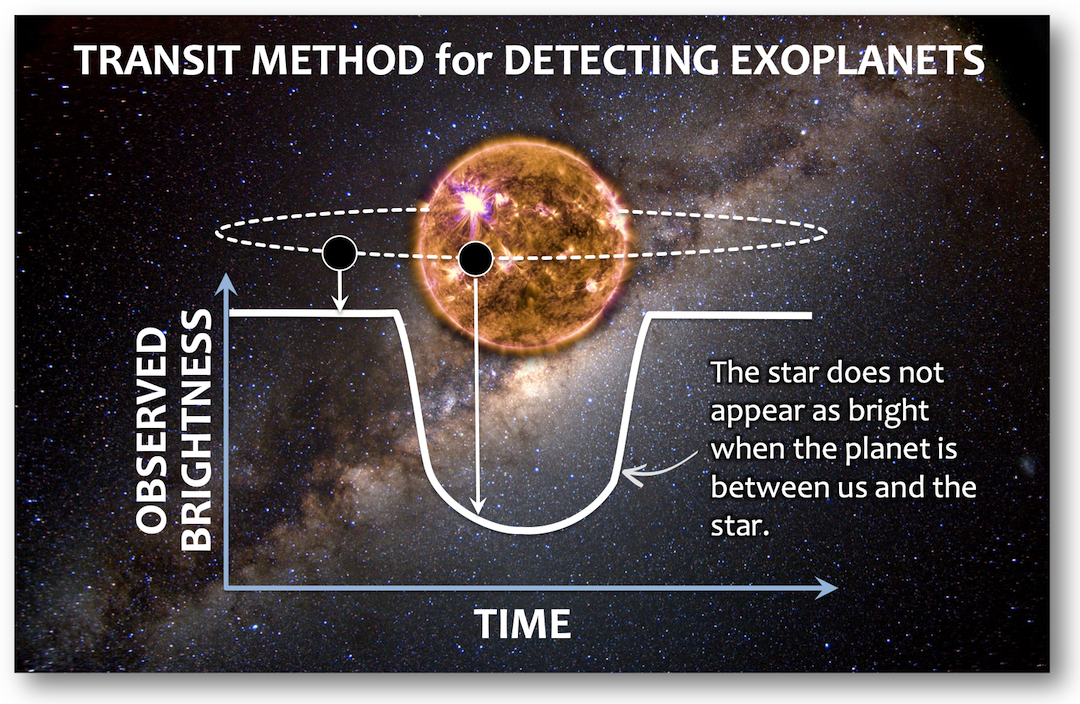
If “other Earths” are defined as planets where we could walk out of a spaceship with no equipment other than a picnic basket, and enjoy a pleasant afternoon on a grassy slope near a stream, then it remains to be seen whether any of these planets fit the description (although NASA’s Exoplanet Travel Bureau would like to make some suggestions for you to explore and find out for yourself; Figure 2.16.)
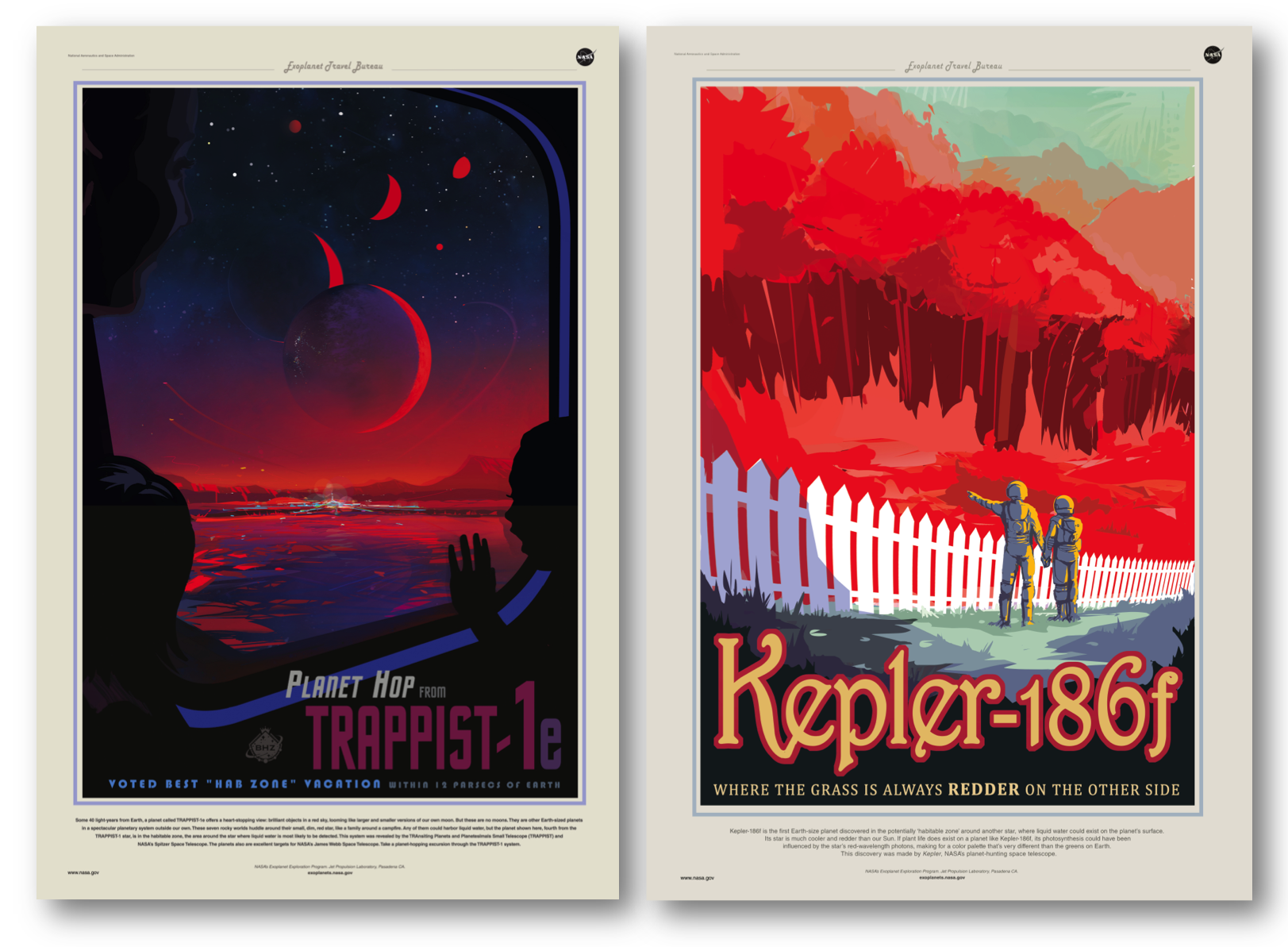
On the other hand, if “other Earths” refers to rocky worlds approximately Earth’s size, and orbiting within their star’s habitable zone (the zone in which liquid water, and potentially life, can exist), then as of the October 2020 update of the Habitable Exoplanets Catalog, it’s possible that we have found 60 such worlds.
Part of the uncertainty about the 60 possible Earth-like worlds is related to their composition. Only five have been confirmed to be rocky, but it’s tempting to conclude that the others are because they’re similar in size to Earth. Remember the rules of the accretion game: you can only begin to collect gas once you’re a certain size, and how much matter you collect depends on how far away from the sun you are. Given how large our gas giant and ice giant planets are compared to Earth, and how far away they are from the sun, we would expect that a planet similar in size to Earth, and a similar distance from its star, should be rocky.
But it isn’t quite as simple as that. We’re finding that the rules to the accretion game can result in planetary systems very different from our own. In the planetary systems we’ve observed, it’s common to have planets larger than Earth orbiting closer to their star than Mercury does to the sun. Planets as large as Jupiter are rare, and where large planets do exist, they’re much closer to their star than Jupiter is to the sun. To summarize, we need to be cautious about drawing conclusions from our own solar system, just in case we’re basing those conclusions on something truly unusual.
On the other hand, the seemingly unique features of our solar system would make planetary systems like ours difficult to spot. Using the transit method, small planets are harder to detect because they block less of a star’s light than larger planets. Larger planets farther from a star—like our gas giant planets—are difficult to spot because they don’t go past the star as frequently. If someone were observing our solar system, they might have to watch for up to 12 years to see Jupiter pass in front of the sun. For Saturn, they might have to watch for 30 years.
Key Ideas About the Hunt for Other Planets
Questions:
- The exoplanet Kepler-452b is within the habitable zone of its star. In our solar system, planets a similar distance from the sun are terrestrial planets. Does Kepler-452b’s distance from its star means it’s a terrestrial planet?
- None of the planetary systems discovered so far are like our solar system. Does this mean our solar system is unique in the universe?
Answers:
- We can’t say from Kepler-452b’s position alone that it’s a terrestrial planet. The fact that we have terrestrial planets close to the sun makes sense in terms of the frost line, but it doesn’t seem to be a hard-and-fast rule in other planetary systems.
- The rules of the accretion game mean there are many complex interactions, so we shouldn’t expect to find a planetary system exactly like ours. At the same time, just because we haven’t found a similar planetary system doesn’t mean there isn’t one. Our methods work best for seeing large planets that orbit close to their stars, whereas our solar system has small planets close to the sun and larger ones farther away. That doesn’t mean our methods won’t eventually turn up a system like ours, just that they’re more likely to turn up systems that are different.
If Habitable Zone Planets Are Terrestrial, Could We Live There?
The operational definition of “other Earths” involving a terrestrial composition, a size constraint of one to two times that of Earth, and location within a star’s habitable zone, does not preclude worlds incapable of supporting life as we know it. By those criteria, Venus is an “other Earth,” albeit right on the edge of the habitable zone for our sun. Venus is much too hot for us, with a constant surface temperature of 465°C (lead melts at 327°C). Its atmosphere is almost entirely carbon dioxide, and the atmospheric pressure at its surface is 92 times higher than on Earth. Any liquid water on its surface boiled off long ago. Yet the characteristics that make Venus a terrible picnic destination aren’t entirely things we could predict from its distance from the sun. They depend in part on the geochemical evolution of Venus, and at one time Venus might have been a lot more like a youthful Earth. These are the kinds of things we won’t know about until we can look carefully at the atmospheres and compositions of habitable-zone exoplanets.
Using Our Solar System to Understand the Kepler-102 Exoplanet System
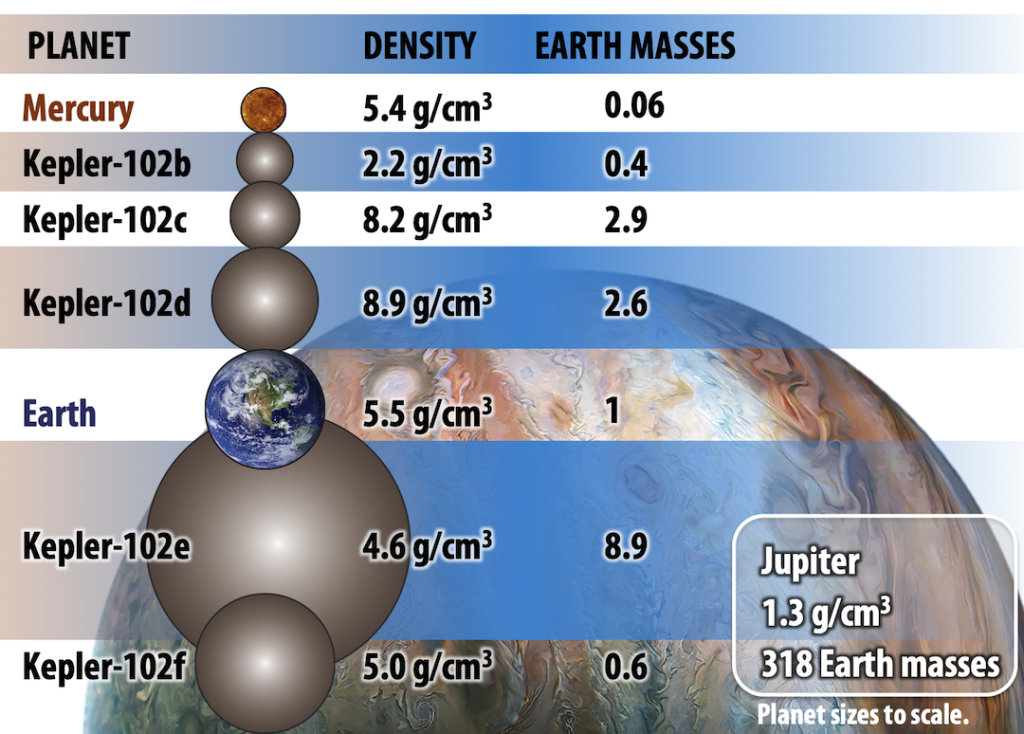 The star Kepler-102 is in the constellation Lyra. Five confirmed planets orbit Kepler-102. This table shows how those planets compare to Mercury, Earth, and Jupiter in terms of size, mass, and density.
The star Kepler-102 is in the constellation Lyra. Five confirmed planets orbit Kepler-102. This table shows how those planets compare to Mercury, Earth, and Jupiter in terms of size, mass, and density.
All of the Kepler-102 planets are closer to their star than Mercury is to the sun.
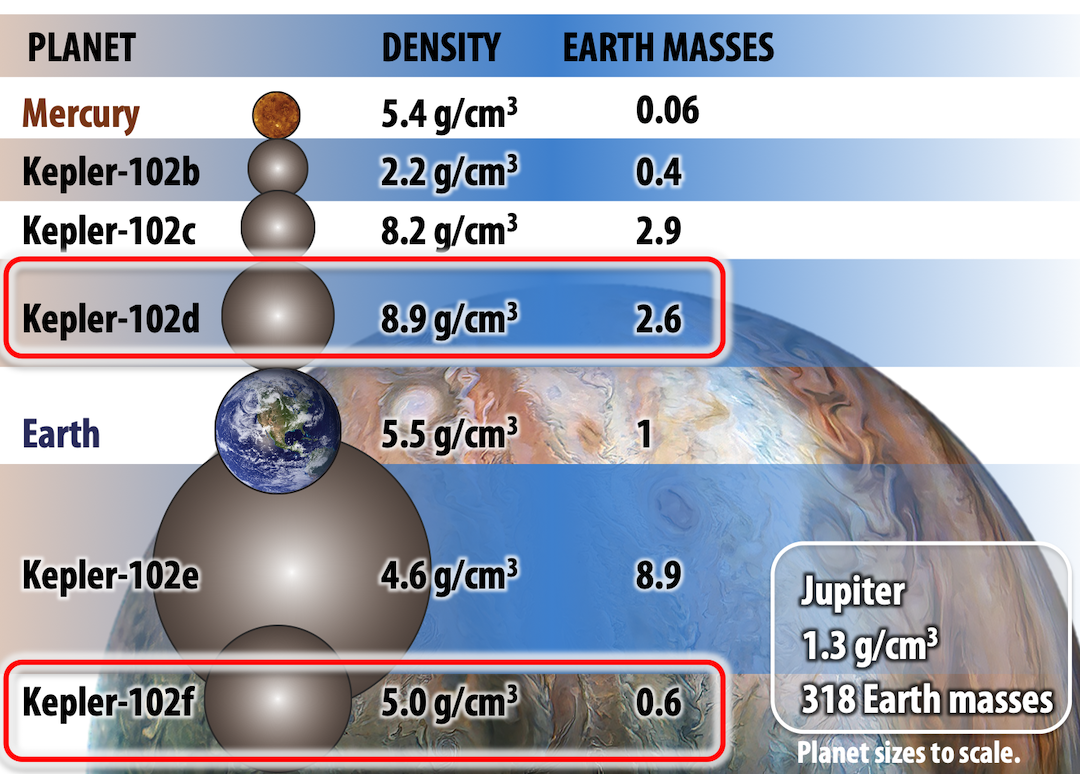
Kepler-102d and Kepler-102f are the closest in size to Earth. Which is most likely to also have a rocky mantle and metallic core like Earth does?
- Kepler-102d (Density of 8.9 g/cm3)
- Kepler-102f (Density of 5.0 g/cm3)
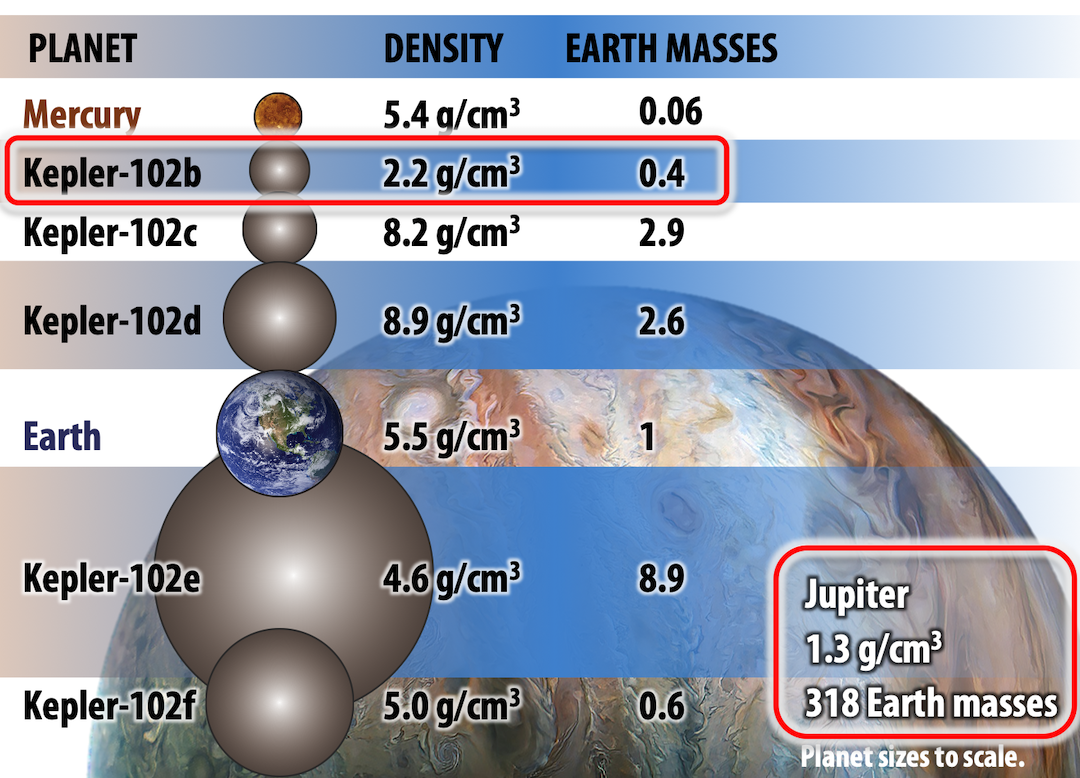
Kepler-102b is closer to Jupiter’s density than Earth’s. Could Kepler-102b have a composition similar to Jupiter’s (i.e., compressed gas with a rocky core), or maybe like an ice giant planet such as Uranus?
- No, it’s definitely not like those planets.
- Yes, it could have a composition like Jupiter or Uranus.
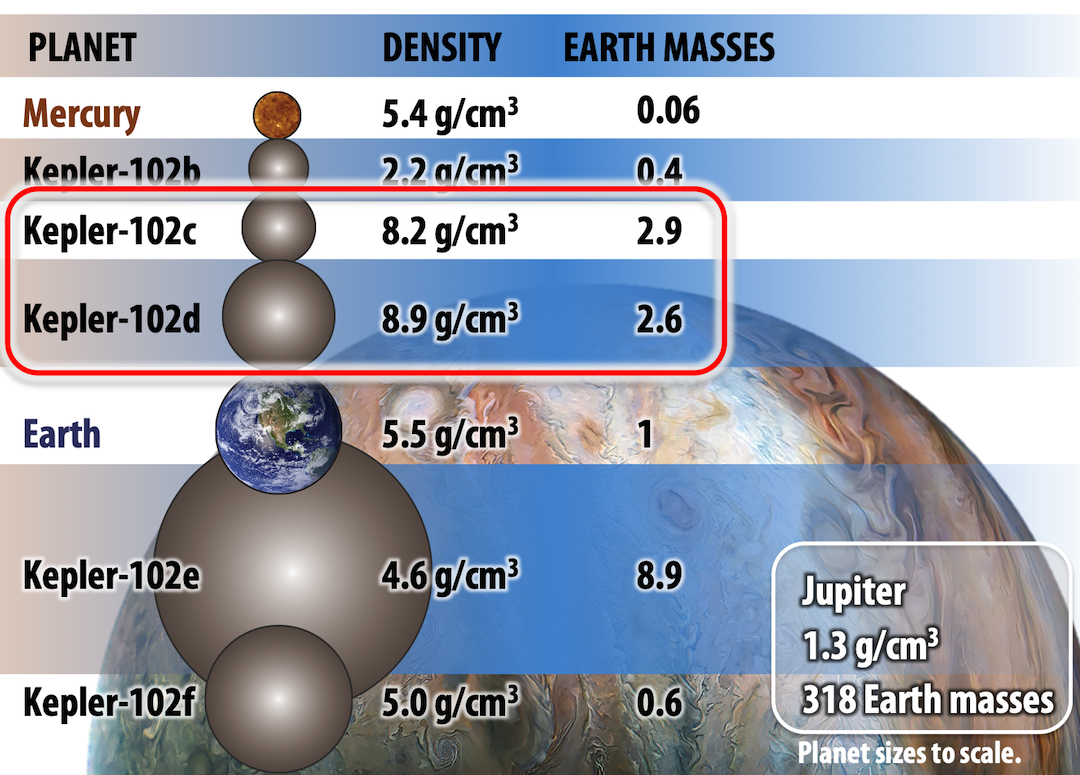
Kepler-102c and Kepler-102d have densities similar to iron meteorites (thought to be from the cores of shattered planets). What example from our own solar system might explain the nature of those planets, assuming they are indeed mostly metallic?
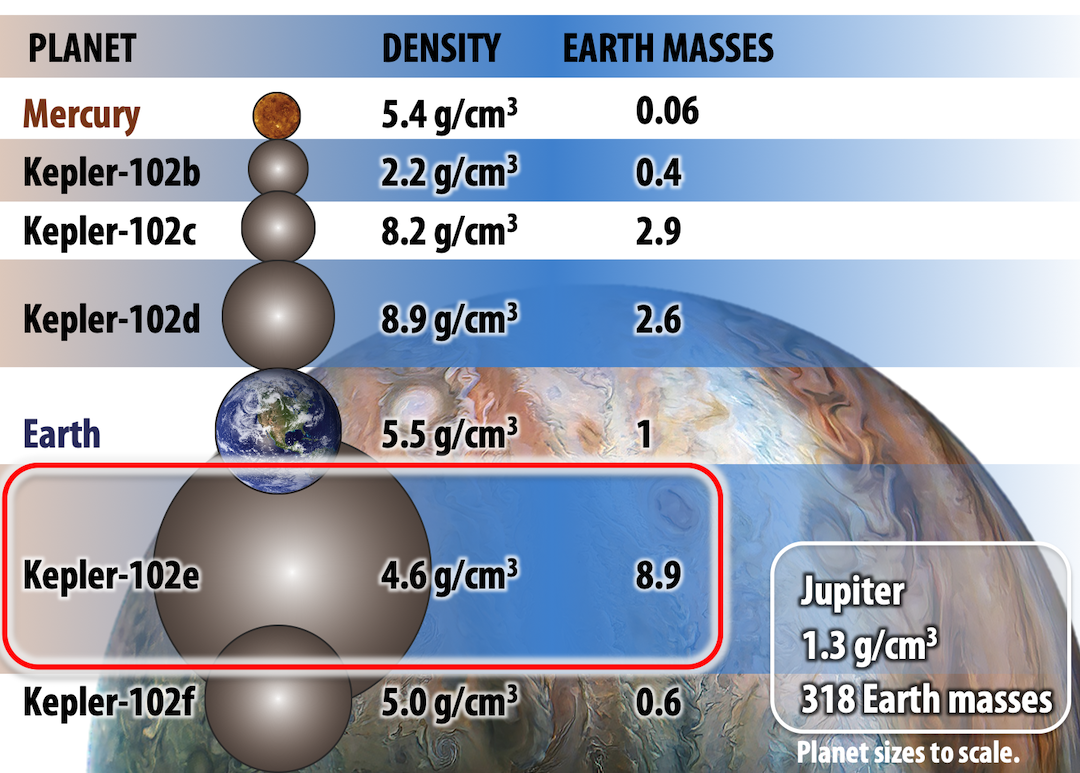
Kepler-102e is twice Earth’s size. Its density is lower, but still consistent with a rocky mantle and metallic core. If it is indeed terrestrial, how might the size of its core relative to its mantle compare to that of Earth?
- It has more core relative to mantle.
- It has less core relative to mantle.
To check your answers, navigate to the below link to view the interactive version of this activity.

